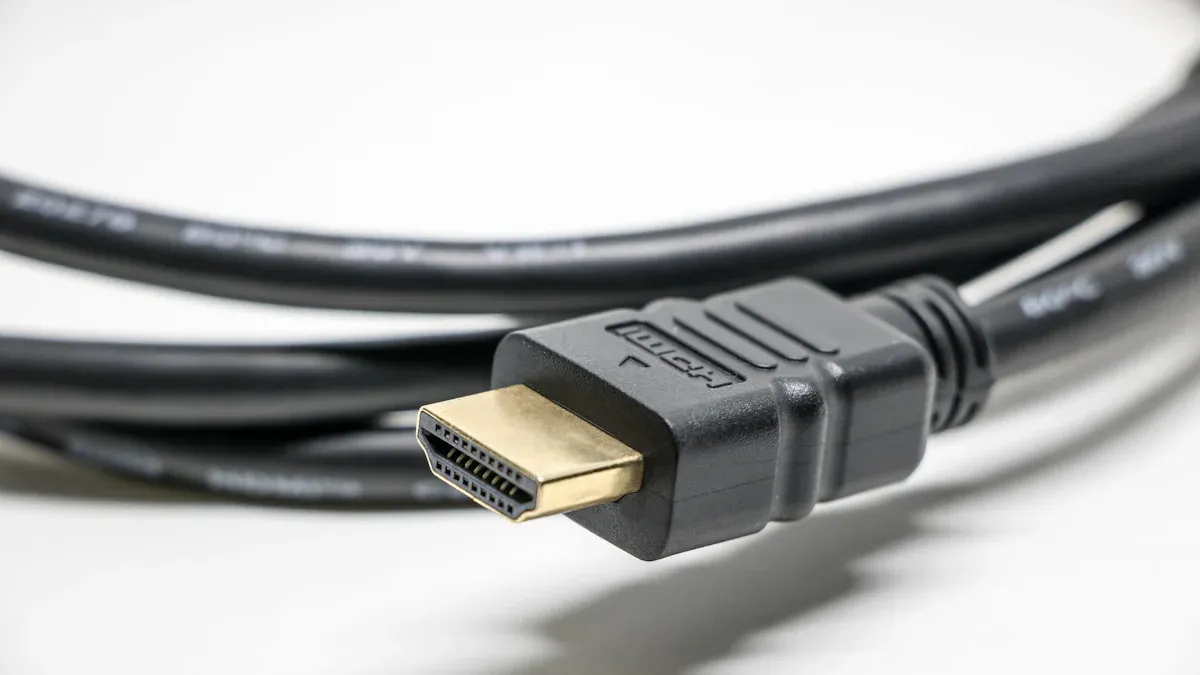
You have lots of good choices if you want to change your vga player box. Some popular picks are monitors with hdmi and displayport inputs, like the Dell S2719 and LG 34UM69G-B. These screens use digital video, so you get better quality and fewer problems than with old analog setups. Most new monitors also have displayport, so they work easily with modern computers. Switching from a vga player box to a digital one is easy and keeps your setup ready for the future.
Key Takeaways
Changing from VGA to digital connections like HDMI, DisplayPort, or USB-C gives you better picture quality and higher resolutions.
Most new devices use digital ports, so upgrading helps your setup work better now and in the future.
Upscalers and converters let you use old devices with new screens without losing picture quality.
Pick cables and devices that fit what you do, like gaming, streaming, or using more than one monitor, to get the best results.
Using HDMI media players, streaming devices, or smart TVs makes watching and using media easier and keeps things tidy.
Why Replace a VGA Player Box?
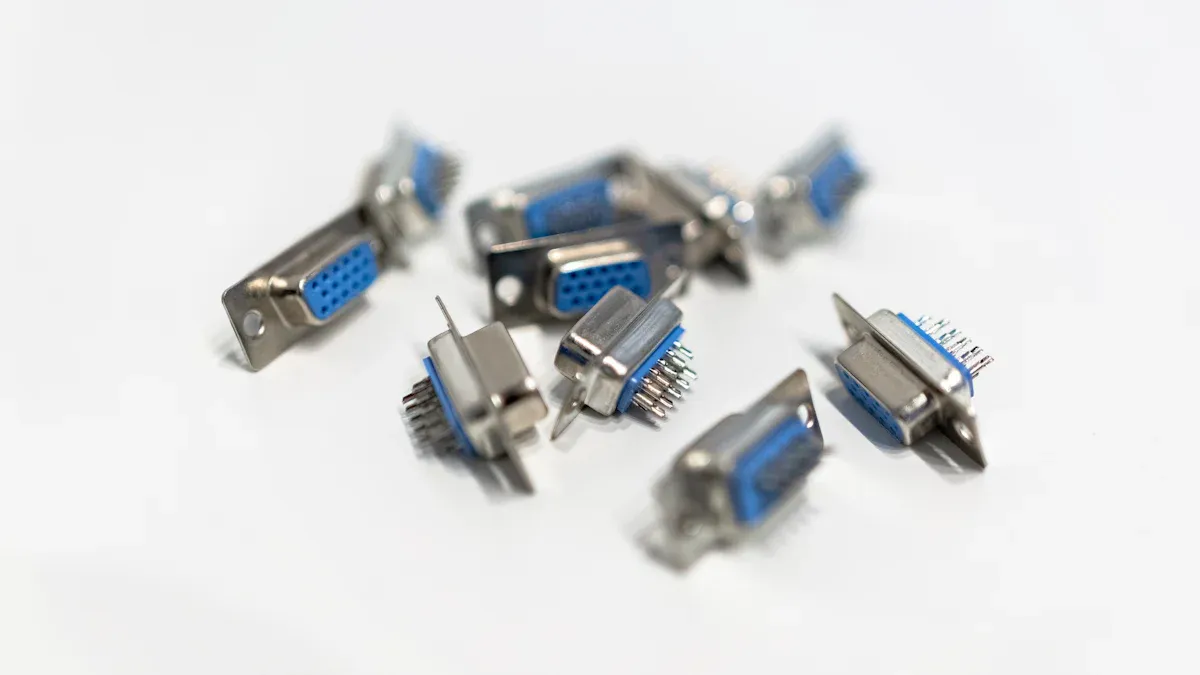
Limitations of VGA
A vga player box has many limits. VGA uses analog signals with a 15-pin connector. This can cause problems with the picture. Long cables or high resolutions make it worse. Here are some problems you might see:
VGA can show up to 1080p, but it looks less clear on big or 4K screens.
The analog signal can get noise, so images may look blurry or have color issues.
VGA cables and adapters are cheap, but you lose image quality and they are less reliable.
The analog design means you cannot get high refresh rates or smooth gaming.
You often need adapters to use a vga player box with new devices, which can make the picture worse.
Tip: Digital connections like HDMI and DisplayPort keep your picture sharp and clear, even with long cables.
Modern Device Compatibility
Most new devices do not use analog connections anymore. Laptops, monitors, and TVs now use digital ports. These ports work better and have more features. The table below shows how VGA compares to digital connections:
Connection Type | Signal Type | Max Resolution | Connector Features | Typical Use in Modern Devices |
|---|---|---|---|---|
VGA | Analog | Up to 1920×1080 @ 60Hz | Bulky, screws needed, signal loss over long cables | Legacy devices, some projectors |
HDMI | Digital | Up to 8K @ 60Hz | Small, screwless, carries audio and video | TVs, monitors, gaming consoles, laptops |
DisplayPort | Digital | Up to 8K @ 60Hz | High bandwidth, multi-display support, screwless | Professional and gaming monitors |
USB-C (Thunderbolt 4) | Digital | Up to 8K @ 60Hz | Compact, reversible, supports video, audio, and power | Modern laptops, tablets, smartphones |
You will see that vga player boxes are not common in new products. Digital connections give you better pictures, faster refresh rates, and extra features like sound and power. If you want to connect your devices easily and get the best picture, it is smart to switch from a vga player box to a digital one.
Best Choices for Modern Setups
You have many ways to replace a VGA player box. Most new setups use HDMI and DisplayPort cables. These cables give you a clear and sharp picture. They also let you use high resolutions. If you want to use old consoles, you can use upscalers or converters. These tools help connect old devices to new screens.
HDMI Media Players
HDMI media players are easy to use. You plug them into your TV or monitor. They work with HDMI or DisplayPort. These players can show 4K and even 8K video. HDMI sends both sound and video in one cable. This makes your setup simple and neat. You get better quality than with VGA. HDMI media players work with most TVs and monitors. They also work with projectors. Some players have extra features like HDR and special sound. You can play media from USB drives or the internet. HDMI media players give you many choices for what to watch.
Note: HDMI and DisplayPort are now the main cables for new devices. They give you high resolution and features that VGA does not have.
Here are some good things about HDMI media players:
Work with new TVs, monitors, and game consoles.
Have HDCP and CEC for easy control.
Streaming Devices
Streaming devices are small and easy to use. You plug them into a screen with HDMI or DisplayPort. You can watch movies, shows, and listen to music online. These devices are cheap and easy to carry. Many let you use voice commands. They get updates often. You can use them for fun or for work.
Device Type | Common Usage | Key Advantages |
|---|---|---|
Streaming Sticks | Home fun, games, smart home control | Small, easy to carry, cheap, makes TVs smart, voice control, gets updates |
Media Players | Fun, learning, work presentations | Plays many types of media, easy to control, streams from the internet, flexible and handy |
Streaming devices can show HD and 4K video. They look better than VGA player boxes. You can use upscalers to play old games on new screens.
Smart TVs
Smart TVs have a screen and streaming device in one. You do not need extra boxes or cables. Smart TVs use Wi-Fi to go online. You can use apps, games, and streaming services right away. This saves space and keeps your area tidy. You can connect other things like game consoles or Blu-ray players.
Smart TVs play media from many places and apps.
You do not need to change cables or use more devices.
The setup is easy and not messy.
You get high definition and even 4K or 8K video.
If you want something simple, a smart TV has everything you need.
USB-C and Thunderbolt Adapters
USB-C and Thunderbolt adapters help you connect laptops, tablets, and phones to screens. Many new devices use USB-C or Thunderbolt for video. These adapters let you send video to monitors with HDMI or DisplayPort.
Feature | USB 3.1 Gen2 Type C | Thunderbolt 3 | Thunderbolt 4 |
|---|---|---|---|
Bandwidth | 10 Gbps | 40 Gbps | 40 Gbps |
Power Delivery | Up to 100W | Up to 100W | Up to 100W (plus 15W for accessories) |
Display Support | One 4K or two 2K screens | Two 4K 60Hz or one 5K 60Hz | Two 4K 144Hz or two 5K 60Hz |
Daisy-Chaining | Not supported | Supported | Supported |
Compatibility | Basic USB-C devices | Works with USB-C devices | Works with Thunderbolt 3 and USB-C |
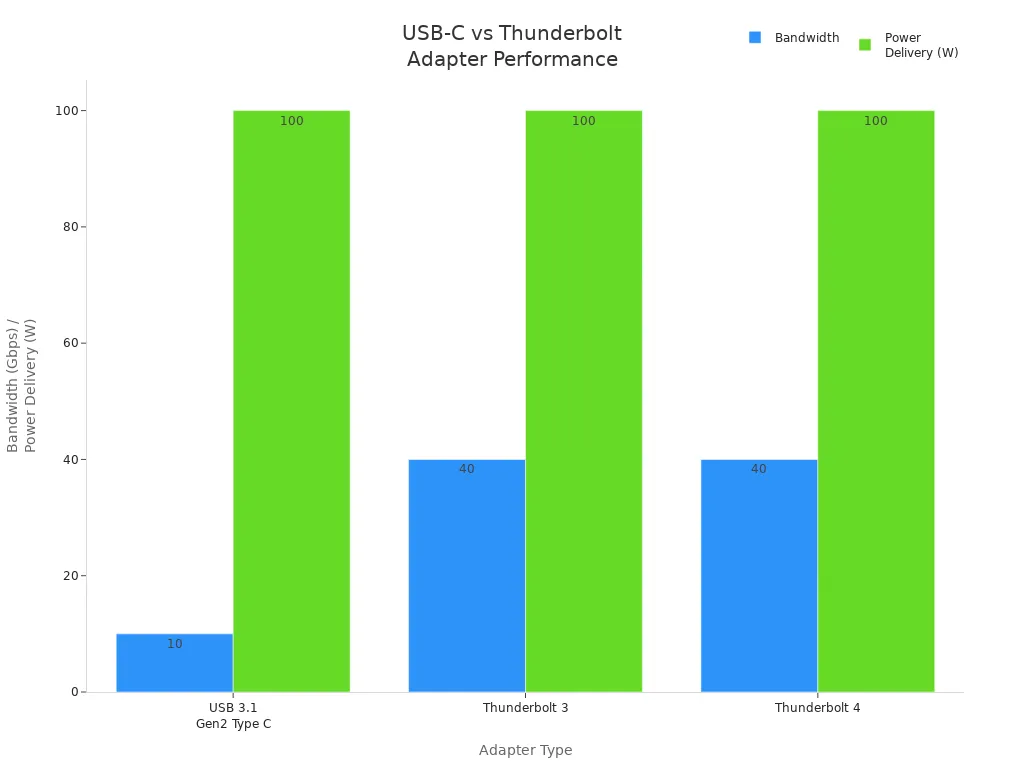
Thunderbolt adapters are fast and can use many screens. USB-C adapters are simple and cheap for daily use. Both types work with most new cables and screens. If you like old games, you can use upscalers to connect old consoles to these adapters.
AV Receivers
AV receivers are like a main station for your devices. You can connect HDMI, DisplayPort, and even VGA with adapters. The receiver sends one HDMI cable to your TV or monitor. This cuts down on cable mess. AV receivers let you switch between game consoles, Blu-ray players, and streaming boxes.
AV receivers can make video look better with upscaling.
Some give better pictures than TV scalers.
You can connect many things and switch between them.
They keep your setup neat and tidy.
If you want to use old consoles, AV receivers with upscalers help you get the best picture. You do not have to use slow converters. Your games will play smoothly.
Tip: When picking from these options, check for input lag, if your console works, sound choices, and if it supports high resolution. The best choice gives you a clear picture and a setup that fits your needs.
Upscalers and Converters

Upscalers and converters help connect old devices to new screens. They change the VGA signal into digital, like hdmi. These tools also make the picture fit your screen’s size. You can use your old gear without losing picture quality. You do not have to buy new, expensive equipment.
VGA to HDMI Adapters
VGA to hdmi adapters let you use old computers or consoles with new screens. You need an active adapter because it changes analog to digital. Passive adapters will not work for this. Good brands, like Cable Matters or Ugreen, support up to 1080p and add audio. The picture may drop a little in quality, but most people think it looks clear.
Adapter Name | Pros | Cons |
|---|---|---|
Cable Matters VGA to HDMI | Easy to use, small, works up to 1080p | Might need extra power |
Ugreen VGA to HDMI | Has audio, strong build | Audio might lag, costs more |
Rankie VGA to HDMI | Cheap, works well | No audio, may not work with all |
Tip: Pick powered adapters for the best results with old devices.
Dedicated Upscalers
Dedicated upscalers do more than simple adapters. They take video from old systems and make it fit your hdmi screen. Devices like BG-UHD-SCVEA or RetroTINK work with many old signals and give a clean picture. These are good for schools, restaurants, and homes. Some even let you get sound and video through hdmi.
Model | Inputs Supported | Output | Special Features |
|---|---|---|---|
BG-UHD-SCVEA | VGA, Composite, Component, HDMI | HDMI | Many inputs, small, works well |
RetroTINK | Old consoles, composite, S-video | HDMI | Low lag, easy to use, great for games |
Dedicated scalers give better pictures and less lag. They are great for old games or showing things on screens.
Capture Devices
Capture devices let you record or stream from old systems. They take the hdmi signal and send it to your computer. Brands like ClonerAlliance and Elgato make popular cards. These tools help you share games, make videos, or save old shows. You connect your old console to the upscaler, then send hdmi to the capture device.
Note: Capture devices do not make the picture better by themselves. You need to use them with upscalers for the best results.
Best Monitor Cable Type
Picking the right monitor cable type helps your devices work well. You want sharp pictures, high resolution, and easy setup. There are many monitor cable types today. Each one is good for different things.
HDMI vs DisplayPort
Most new screens have hdmi and displayport. Both can show high resolution and fast refresh rates. Hdmi is found on TVs, game consoles, and many monitors. Displayport is used a lot on desktop computers and fancy monitors.
Feature | DisplayPort 1.4 | DisplayPort 2.1 | HDMI 2.0 | HDMI 2.1 |
|---|---|---|---|---|
32.4 | 80 | 18 | 48 | |
Maximum Resolution | 8K @ 60Hz | 10K @ 60Hz | 4K @ 60Hz | 8K @ 60Hz (compressed) |
Displayport has more bandwidth than hdmi, especially older hdmi. This means you get higher resolution and faster refresh without losing quality. Hdmi 2.1 is now closer to displayport, but it sometimes uses compression for big resolutions. Displayport lets you use more than one monitor with one cable. Hdmi is easier to find on TVs and home stuff.
Tip: If you play games or use many monitors, displayport is usually best. For TVs and home theaters, hdmi is a better pick.
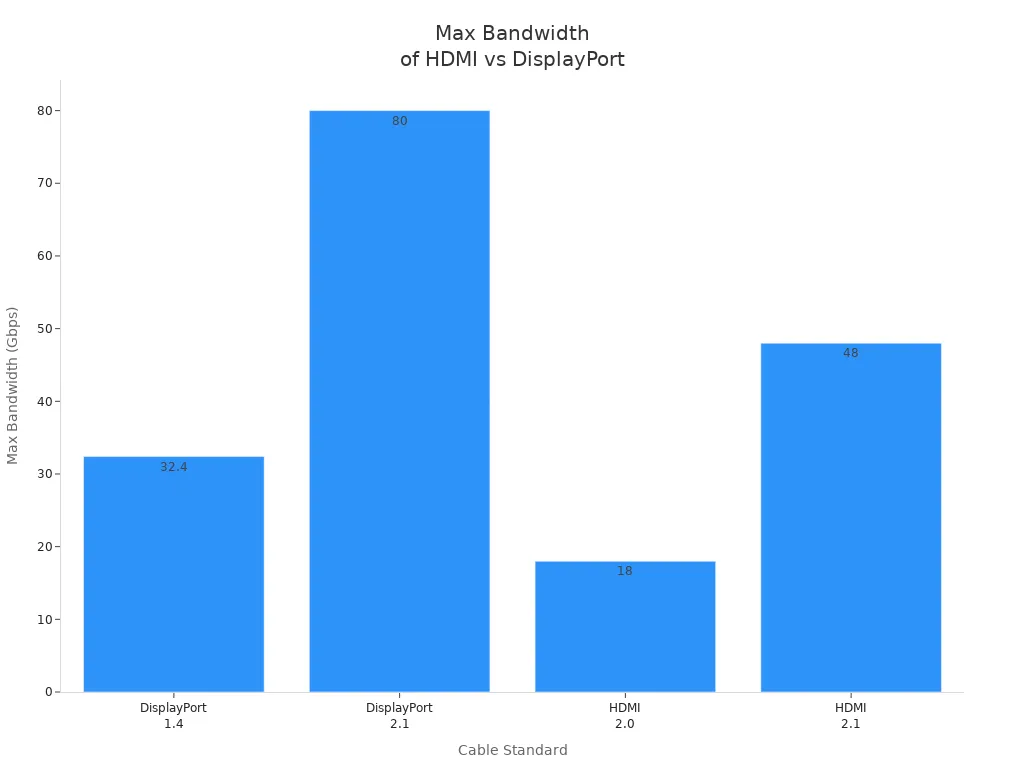
DVI and USB-C
Some old monitors still use DVI. This cable type can show up to 2560×1600 resolution but does not send sound. DVI is best for old devices. Usb-c is a newer cable type. Usb-c can send video, sound, data, and power in one cable. Many laptops and tablets use usb-c for screens. Usb-c with DisplayPort Alt Mode can show up to 8K resolution.
Cable Type | Audio Support | Device Support and Use Case | |
|---|---|---|---|
DVI | Up to 2560×1600 @ 60Hz | No | Old devices; digital video only; no sound |
USB-C | Up to 8K @ 60Hz | Yes | New devices; video, data, power; docking and charging |
HDMI (2.1/2.2) | Up to 12K-16K @ 60-120Hz | Yes | TVs, consoles, monitors; sound and high resolutions |
DisplayPort (1.3/1.4) | Up to 8K @ 60Hz | Yes | Gaming, pro monitors; daisy-chaining, HDR |
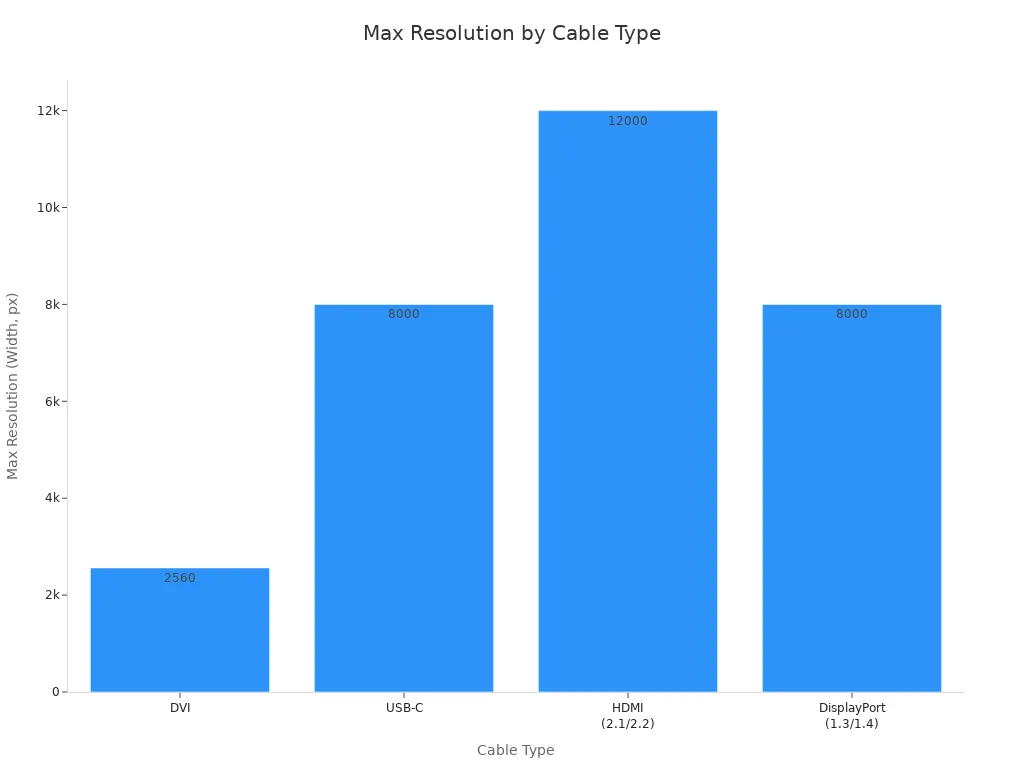
When you choose a monitor cable type, think about what your devices need. Usb-c and displayport are great for new computers and fancy monitors. Hdmi 2.1 is best for TVs and games. DVI is only for old setups. There are many monitor cable types, so you can always find one that works for you.
How to Choose
When you pick an alternative to a VGA player box, you want to make sure it fits your needs. You should look at a few key factors before you decide. These include device compatibility, how easy the setup is, and your budget for the upgrade. Matching the right solution to your devices and display requirements will help you get the best results.
Device Compatibility
Start by checking what devices you want to connect. Look at the ports on your TV, monitor, or projector. Most new devices use HDMI or DisplayPort. Older devices might need adapters or special cables. If you want to use a console or a classic computer, you may need an upscaler or a converter. Make sure the connection type matches both your device and your display. Sometimes, you need to update drivers or adjust display settings to fix compatibility issues. Always test your cables and adapters to avoid problems with signal quality or resolution.
Setup Simplicity
You should choose a solution that is easy to set up. HDMI and USB-C connections often work right away. You just plug them in, and they start working. Wireless options like streaming devices can also make things simple. If you use adapters or upscalers, follow the instructions to connect everything in the right order. Shorter cables usually give you better signal quality. If you have trouble, try a different cable or check your device settings. A simple setup saves you time and keeps your space tidy.
Budget and Future-Proofing
Think about your budget before you buy new equipment. Some options, like HDMI media players or adapters, cost less. Others, like smart TVs or AV receivers, may cost more but offer extra features. Try to pick a solution that will last for years. Look for devices that support high resolutions like 4K or 8K. This way, you will not need to upgrade again soon. If you plan to add more devices later, choose a setup that can grow with your needs.
Tip: Make a list of your devices and what you want to connect. This helps you pick the best option for your setup.
Quick Comparison Table
Pros and Cons
When you want to connect your devices, you need to know what works best. Every choice has good things and some problems. The table below shows how the main options compare. You can use it to help you decide.
Connection Type | Strengths | Weaknesses |
|---|---|---|
VGA | Works with old CRT monitors; easy to find on old computers | Low picture quality; no sound; does not support high resolutions; outdated |
DVI | Good for HD monitors; supports up to 2560×1600 resolution | No 4K support; no audio; less common on new devices |
HDMI | Sends video and sound in one cable; found on most TVs and monitors | Only one video stream per port; needs HDMI 2.0 for 4K at 60Hz |
DisplayPort | Handles very high resolutions (up to 8K); supports many screens at once | No device control commands (like CEC); not on all TVs |
USB-C | Small and reversible; sends video, sound, data, and power | Needs compatible devices; may need adapters for some screens |
Upscalers/Converters | Lets you use old devices with new screens; improves picture quality | Can add some lag; may cost more than simple adapters |
Smart TV/Streaming Device | Easy to set up; gives access to apps and streaming services | May not work with very old devices; sometimes needs internet |
AV Receiver | Connects many devices; can improve sound and video; keeps setup tidy | Can be expensive; setup may be harder for beginners |
Tip: If you want the best picture and sound, HDMI and DisplayPort are strong choices. For old devices, upscalers or converters help you keep using your gear.
HDMI and DisplayPort give you great quality and lots of features. USB-C is good for new laptops and tablets. Upscalers and converters let you use old consoles or computers. Smart TVs and streaming devices are easy if you want to watch apps and shows. AV receivers are helpful if you have many devices and want a neat setup.
Pick the option that works with your devices and how you use them. This table makes it easy to see the main good and bad points.
Setup Guide
HDMI Media Player Setup
You can set up an HDMI media player in just a few steps:
Plug the HDMI cable into the media player and your TV or monitor.
Connect the power adapter to the media player and plug it into a wall outlet.
Turn on your TV or monitor and select the correct HDMI input.
Use the remote control to follow the on-screen setup instructions.
Tip: Use a high-quality HDMI cable. Shorter cables work best for high resolutions like 4K.
If you see no picture, try another HDMI port or check if the cable is damaged. Make sure your TV’s HDMI port is set to the right signal format for the best image.
Streaming Device Setup
To set up a streaming device, follow these steps:
Plug the streaming device into an HDMI port on your TV.
Connect the power adapter to the device and plug it into a wall outlet.
Turn on your TV and select the correct HDMI input.
Follow the on-screen prompts to connect to Wi-Fi and sign in to your account.
Note: Always use the power adapter that comes with your device. Some TVs do not give enough power through USB ports.
If the device does not start, check the power connection and try a different HDMI port.
Upscaler Connection
You can use an upscaler to connect old devices to new screens:
Connect your old device’s video output (like VGA or SCART) to the upscaler’s input.
Use an HDMI cable to connect the upscaler’s output to your TV or monitor.
Plug in the upscaler’s power supply.
Set your TV to the correct HDMI input.
Check that all cables are secure and not worn out. If you see a poor picture, make sure the upscaler supports your device’s resolution.
Adapter Installation
To install an adapter:
Plug the adapter into your device’s video output port.
Connect the other end to your TV or monitor with the right cable.
Secure all connections tightly.
If you have no signal, test with another cable or check if your devices support the chosen resolution. Research compatibility before buying adapters to avoid problems.
Tip: Always match the cable type to the signal, not just the connector shape. This helps prevent signal issues.
You can pick from lots of choices to swap out a VGA player box. Digital connections like HDMI, DisplayPort, and USB-C make pictures look clearer. They also let you use higher resolutions. Upscalers let old devices work with new screens. When you choose a monitor cable, check if it fits your device. Look at the resolution, refresh rate, and if it sends sound.
Factor | Why It Matters |
|---|---|
Device Compatibility | Makes sure your stuff connects |
Resolution/Refresh | Gives you smooth, clear video |
Audio Support | Sends sound with the picture |
Bandwidth | Moves high-quality signals |
Make your setup better and easier to use by upgrading.
FAQ
What is the best monitor cable type for high resolution output?
HDMI 2.1 and DisplayPort give you the sharpest picture. These cables support very high resolutions and clear video. USB-C with DisplayPort Alt Mode also works for modern screens. Always check if your devices work with these cables.
Can I use upscalers or scalers to connect classic consoles to new TVs?
Yes, you can use upscalers or scalers for classic consoles. They change analog signals into digital video for new TVs. This gives you better quality and smoother games. Many retro gamers like using upscalers for old games.
How do I choose between HDMI, DisplayPort, and USB-C?
Look at your devices and what screen quality you want. HDMI is good for TVs and most monitors. DisplayPort is best for gaming and very high resolutions. USB-C is great for new laptops and tablets. Each cable type works with different devices.
Do I need a vga player box for retro gaming?
You do not need a vga player box for retro gaming. Upscalers and digital adapters work better for old consoles. They give you high definition and a clear picture. You can use these for a better gaming experience.
What should I consider for the best choices on a budget?
Compare your options by quality, resolution, and price. HDMI adapters and USB-C cables usually cost less. Upscalers and AV receivers cost more but have extra features. Pick what fits your budget and needs for the best choice.
See Also
Best AI-Powered Video Devices for Vehicles in 2025
Wireless AI CarPlay Devices Compatible With All Vehicles
Comparing Wireless CarPlay Adapters And AI Boxes For Value
